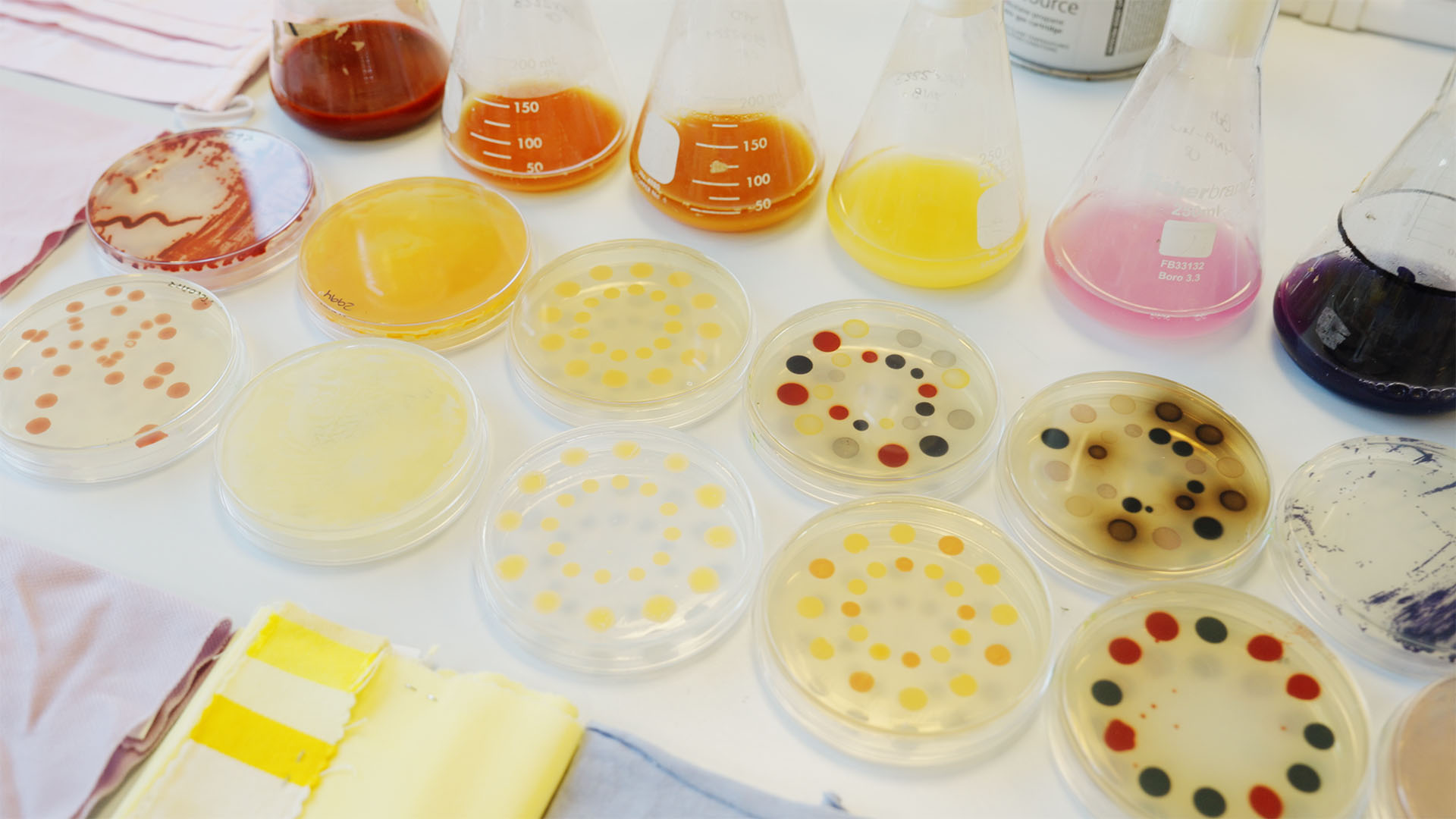
Dyestuff Library
This project was designed to address the gap in knowledge and infrastructure for sustainable dyes by developing a tool to identify, assess, and select innovative dyestuffs based on specific metrics and fabric requirements. The project collaborates with brands, supply chain partners, and industry stakeholders to conduct comprehensive evaluations, aiming to facilitate an industry shift toward sustainable dye options. Structured in multiple rounds, each involving five innovators, the project includes trials at both lab and pilot scales, with support and guidance for participating innovators.
Problem Statement
Traditionally pretreatment, colouration and finishing are referred to as wet processes as they take place in large tanks or baths filled with water that is constantly kept at a high temperature. Alongside the pretreatment, colouration and finishing steps, a significant amount of water and chemistry is wasted as the fabrics also have to be washed off to remove excess dyes and chemicals. Approximately 10-50% of dyes are washed out in this process, ending up in the effluent water.
Natural dyes and pigments, from sources like algae and plants, have existed for centuries but have historically been overlooked by the fashion industry due to inferior performance, limited colour palette and higher prices than synthetic dyes. However, new disruptive cultivation, extraction and application processes have the potential to overcome these barriers and enable the (re)implementation of natural dyes at scale. Using natural dyes and pigments enables a shift away from synthetic chemistry and in some instances the feedstock used ie: plants, algae or waste means the dyes and pigments have the potential to be carbon negative. However, uncertainty around these alternatives’ scalability, performance, and standardisation has hindered widespread adoption. The industry lacks a reliable framework to evaluate and implement these sustainable dye options, posing a challenge for brands to transition to environmentally friendly practices effectively.
Executive Summary
Fashion for Good launched this project in April 2023 in collaboration with brand partners adidas, Inditex, bonprix & Otto International, BESTSELLER, Target and Patagonia. Alongside manufacturing partners Paradise Textiles, Welspun and Shahi Exports. This project establishes a Sustainable Dyestuff Library to enable the textile industry’s shift toward alternative dyes by providing a reliable tool for evaluating sustainable dye options. Collaborating with leading brands, supply chain partners, and experts, the project rigorously tests innovative dyes through compliance, lab, and pilot trials, with each phase concluding in environmental impact assessments.
Spanning from 2023 to 2025, the project will culminate in a digital library accessible to partners, offering verified performance metrics to support sustainable dye selection. This tool aims to foster broader industry adoption of sustainable dyes, driving transparency and promoting sustainable dyeing practices across the sector.
Goals of the Project
-
Create a sustainable dye library with key performance metrics including feedstock, pigment, application, scalability, TRL, capacity, price, impact and trial results.
-
Through the library create a decision framework tool that will enable partners to choose the best suitable dyestuff for their requirements.
Project Results
Upon completion, the Dyestuff Library digital tool will be accessible to project partners, offering verified performance metrics and assessments of alternative dyestuffs. Key results will include insights from lab and pilot trials, comprehensive data on compliance with toxicity and MRSL standards, and screening LCA findings that pinpoint environmental impact hotspots and suggest areas for improvement.
This project will conclude in Q2 2025 when the high level results will be shared.
Timeline
The project spans two years and started in 2023, structured around three sequential rounds, each involving five innovators. Each round follows this order:
-
Compliance Testing
MRSL and toxicity screening are conducted for the selected innovators to ensure compliance with safety standards.
-
Lab Trials
Innovators who pass compliance testing enter lab trials, progressing through increasing scales of fabric dyeing to assess initial performance.
-
Pilot Trials
Innovators meeting lab trial standards move to pilot trials, where scalability and application on larger fabric samples are evaluated.
Each round concludes before the next begins, with a screening LCA performed by Fashion for Good to evaluate environmental impact.
Innovation Partners
Project Partners
Implementation Partners
Support
Relevant Resources

Fashion for Good Develops a Sustainable Dyestuff Library

In Conversation with Alchemie Technology: Transforming Dry Processing for Textile Dyeing and Finishing

In Conversation with Colorifix: Revolutionising Textile Dyeing with Biotechnology

In Conversation with NTX: Pioneering Digital Dyeing

In Conversation with imogo: Reimagining Spray Dyeing
Other Projects

The Next Stride: Bio-based Materials for Footwear Soles
“The Next Stride: Bio-based Materials for Footwear Soles” aims to validate the performance and environmental impact of bio-based polymers as sustainable alternatives to the fossil fuel-derived materials currently used in footwear soles. The objective is to collectively de-risk the transition to these “next-generation” materials by rigorously testing their technical properties and assessing environmental benefits. Ultimately, the purpose is to accelerate the adoption of these bio-based solutions and pave the way for a more sustainable footwear industry.

Beyond50 Denim: Combining Cottonised Hemp And Green Chemistry
“Beyond50 Denim: Combining Cottonised Hemp And Green Chemistry” aims to validate the performance and environmental impact of cottonised hemp processed with green chemistry to act as a true alternative to cotton in denim applications. The project goal is to evaluate the performance of SEFF’s cottonised hemp fibre in combination with Fibre52’s bio-friendly chemistry solution within denim fabric applications with a total hemp content of 50% and above. The fabrics will be benchmarked against conventional 100% cotton denim with a specific focus on handfeel and aesthetic characteristics.

Price Parity Toolkit
The Price Parity Toolkit (PPT) was designed to help bridge the price gap between next-gen* and conventional materials. Developed by Fashion for Good with the support of Canopy, this industry-supported framework introduces a financing mechanism that decouples price premiums at early stages of the supply chain to enable adoption and drive the scale of lower-impact materials.














